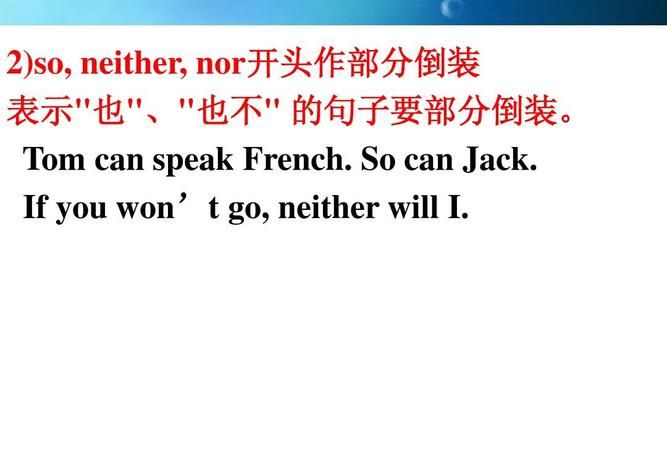本文目录
英文倒装句
倒装句分为全倒装和部分倒装两种类型。
英语句子使用的目的,可分为四大类:陈述句、疑问句、祈使句和感叹句。这四大类型句子都有可能出现倒装句。浅析如下:
一、疑问句中出现的倒装句
1. 特殊疑问句中
(1)What is this?(全倒装)
(2)Which do you want?(部分倒装)
2. 一般疑问句
(1)Do you study English every day?(部分倒装)
(2)May I come in?
(3)Are you going to be a teacher?
特殊疑问句中,如果疑问词做主语或疑问词修饰主语时,句子不用倒装,即用陈述语序。例如:Who did it yesterday? Which guy can do this work?
一般疑问句中,常把助动词或情态动词放在句首,即位于主语前,而构成部分倒装。
二、感叹句中出现倒装句
1. What引导的感叹句
(1)What a happy life we have had!(宾语在主语前面)
(2)What a fine day it is!(表语在主语前面)
(3)What a shining example Comrade Lei Feng has set us!
2. How引导的感叹句
(1)How happy we are!(表语在前面)
(2)How hard they are working!(状语在前面)
(3)How nice a day it is!
3. 副词引导词引导的感叹句
(1)There comes the bus!
(2)In come the students!
(3)Off goes the worker!
What或how 引导的句子,主谓也有不倒装的。
What所强调的重点是名词,这一名词一般是表语或宾语,有时所强调的名词可能是主语。例如:What enormous crowd came!(《当代英语语法》中册P87)。What也可单独使用。例句:What she suffered in the old days!(《英语分类句型》P90)
How修饰形容词、副词或动词。有时how many的搭配也可修饰名词。For how many years have I waited! 该短语作状语。(《当代英语语法》)
副词引导词位于句首,一方面为了强调,另一方面使情景生动。主语是名词时,主谓倒装;如果主语是人称代词,主谓不倒装。例如:Away he went to the station!
三、祈使句中出现的倒装
1. Long live the king! (《最新实用英汉辞典》P769)
2. Long live the People’s Republic of China!
3. May you succeed! 祝你成功!
Long may he live! 愿他长命百岁!(《英华大辞典》P780)
4. Don’t you open the door. Don’t anyone open the door.(《当代英语语法》中册P85)
祈使句一般无主语,有时也有主语出现。祈使句的主语要重读,代词也要重读(陈述句的主语一般不重读)。祈使句常用句号。表示一种强烈感情时,句子用感叹号。
四、陈述句中出现的几种倒装句
1. 主谓倒装
(1)Long long ago, there was a war between the birds and the beasts.
(2)Once upon a time there were six blind men in India.
(3)“Come along, then.” said the bird.
(4)...but toward the end there came the terrible storm...
2. 表语倒装
(1)Such was Albert Einstein,a simple man of great achievements.(全倒装句)
(2)Inside the pyramids are the rooms for the bodies of kings and queens.
(3)A very reliable person he is.(主语是人称代词时,主谓不倒装)(《英语分类句型》P400)
3. 宾语倒装
(1)Many happy hours she had spent planning for something nice for him.
(2)Twenty-one dollars they took for it.
(3)Not a single mistake did he make.
(4)Only a dictionary he never forgets to bring here.
宾语在前时,多数属于强调部分,句子一般不加助动词,偶尔也有助动词出现,如例句(3)。
五、复合句中的倒装
(1)I take back what I said.
(2)...and the ship would have sunk with all board had it not been for the captain.(要是没有那位船长,就会连船带人都沉没了。)
(3)Were I you,I would go with him.
(4)Proud as these nobles are,he is afraid to see me.
(5)Not only was everything that he had taken away from him,but also his German citizenship.
(6)Hardly (Scarcely)had he sat down when the telephone rang.
(7)The harder you work, the greater will be your achievement.
六、其他倒装
陈述句中为了保持句子平衡或为了强调表语、宾语、状语等成分,或使上下文紧密衔接时,使用倒装句。
(1)On the wall is a blackboard on which were written some words,“It is no use sitting here without listening to me.”(定语从句中,主语的同位语太长)
(2)They entered the classroom,in front of which sat a naughty boy.(使上下文紧密衔接)
(3)Gone forever are the days when the Chinese people were looked down upon by the foreigners.(主语加上定语后太长而表语短,所以表语在前面,强调句子平衡)

英语倒装句12种类型及例句初中
英语倒装句12种类型及例句如下:
1、“there be”结构
在这一结构里,there是引导词,主语在be后。
There is a box on the table.
桌子上有个盒子。
2、疑问句
疑问句为倒装形式。
Is she singing in the classroom?
她是不是正在教室里唱歌?
3、here、there等副词开头的句子(部分)
在here、there等副词开头的某些句子中,如果主语是人称代词,主语和主要动词的词序不变。
There goes the bell.
铃响了。
4、重复倒装句型
在以so、nor、neither开头,表示谓语所述的情况,也适用于另一个人或一事物的肯定或否定句中。so用于肯定句,表示“也一样”、“也这样”;nor、neither用于否定句,表示“同样也不,也不这样”。
I am watching TV. So is she.
我在看电视,她也是。
5、直接引语的全部或一部分放在句首时,主句中的主谓也常直接倒装
"Very well," said the French student.
“很好”,那个法国学生说道。
6、否定副词开头的句子(部分倒装)
在以never、little、hardly、not only、few、not、seldom等否定副词开头的句子中,采用部分倒装;如果不放在句首就不要倒装。
Little did he say at the meeting.
在会上他没说话。

7、以only所修饰的副词、介词短语或状语从句的句子
Only when the war was over in 1918 was he able to get happily back to work.
只有1918年战争结束,他才能开心地重归工作。
8、地点、方位副词在句首(完全倒装)
为了表达生动,有时把表地点、方位的副词,如up、down、out、away、in等放在句首,同时把谓语动词放在主语之前。若主语为人称代词,主语和谓语动词的位置不变,只将副词放在句首。
Away hurried the boy.
男孩匆忙走开了。
9、虚拟结构中
在虚拟结构中,条件从句的谓语含有were、had和should这三个词是,可省去if,将这些词移至主语之前。
Had I time (= If I had time), I would go and help you.
如果我有时间,我会去帮助你的。
10、as引导的让步状语从句
as引导让步状语从句时要倒装(形容词/副词/名词/动词+as+主语+谓语)。
Proud as they are, they are afraid to see me.
他们很傲慢,但是也害怕看到我。
11、祝愿的句子
用于某些表示祝愿的句子里。
May you succeed!
祝你成功!
12、So+形容词、副词及such置于句首时
So happy did he feel.
他感觉非常开心。
英语改倒装句怎么改
第二句本来就是倒装句啊。
第一句改为倒装句为Not until you had explained how did I manage to do it.

英语倒装句有哪些类型
I. 完全倒装
1. 用于 there be 句型.
2. 用于“ here ( there, now, then )+不及物动词+主语”的句型中,或以 in, out, up, down, away 等副词开头的句子里,以表示强调.
注意:
( 1 )主语是代词时,主语和谓语不倒装.
( 2 ) here , there 放在句首通常用一般现在时.
3. 当句首状语为表示地点的介词词组.
4. 表语置于句首时,倒装结构为“表语+连系动词+主语”:
( 1 )形容词+连系动词+主语
Present at the meeting were Mr Li, Mr Wang and many other teachers.
出席会议的有李老师、王老师和其他很多老师.
( 2 )过去分词+连系动词+主语
Gone are the days when we used foreign oil.
我们使用洋油的日子一去不复返了.
( 3 )介词短语+ be +主语
Among the goods are books, exercise-books, pens and some other things.
在所有的货物中有书、练习册、钢笔和其他东西.
5. 用于 so, neither , nor 开头的句子,表示重复前句的部分内容.原句的谓语应与前句的谓语的时态、形式相一致.
例如:You can't speak French. Neither can she.
你不会说法语,她也不会.
6. 为了保持句子平衡,或为了强调表语或状语,或是上下文紧密衔接时.
例如: They arrived at a small village, in front of which was a big river.
他们来到一个小村庄,村庄前面是条大河.
II. 部分倒装
1. 用于疑问句.
例如: Do they work in the factory?
他们在这家工厂上班吗?
2. 用于省略的虚拟条件状语从句.
例如: Had I seen him yesterday wouldn't go to his house now.
如果我昨天见到他了,我现在就不去他家了.
3. 用于“形容词(或名词、动词) +as ( though )”引导的让步状语从句中.例如:
Try as he would, he might failed again.
他虽然可以试试,可能还会失败.
注意:如果从句的表语是名词,其名词前无形容词时,不用冠词;若有形容词要用冠词.
Child as he was, he had to make a living.
他虽是个孩子,但得糊口.
4. 用于 no sooner … than … , hardly … when 和 not until 等句型.
No sooner had I come in, the telephone rang.
我刚进屋,电话铃就响了.
5. 用于 never, hardly , seldom, scarcely, barely, little, at no time, not only 等开头的句子.
Seldom does he come late. 他很少迟到.
6. 用于“ only +状语”开头的句子.
Only then did he know he was wrong.
直到那时他才知道他错了.
7. 用于“ so +形容词 / 副词”放在句首的 so … that 句子.
So fast is he running that he can keep up with the bike.
他跑得快得能跟上自行车.

以上就是关于英语倒装句两句,英文倒装句的全部内容,以及英语倒装句两句 的相关内容,希望能够帮到您。

